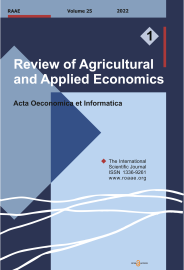KEYWORDS:
efficiency; Ghana; dry bean; groundnut; technology gap
DOI NUMBER:
10.15414/raae.2021.24.01.76-87
ABSTRACT:
Research background: A combination of technology and efficiency gains will drive future intensification programs aimed at fostering food and nutrition security in the developing world. Specifically, the adoption of improved varieties and use of quality seed alongside good agronomic practices will be critical.Purpose of the article: Given the space-time availability of technology, this study investigates how production efficiency (technical efficiency, technology gap, and meta technical efficiency) has changed over time and assesses the possibility of heterogeneous technology adoption in Ghana.
Methods: The study constructs a rich nationally representative dataset of dry beans and groundnut farmers that constitutes 15 production seasons in Ghana. Using a sample of 10,518 farmers from 10,051 households, a Meta Stochastic Frontier (MSF) approach is used to access changes and determinants efficiency and technology adoption.
Findings & Value added: We find that farms are operating under heterogeneous technologies along ecological lines and that the technology gap has been reducing over time. Improvements in meta technical efficiency could be driven by the gains in the technology gap ratio. Technical efficiency levels across the two legumes averaged about 61% and did not significantly improve between 1987 to 2017. The key determinants for the observed trends were farmer education, mechanization, access to agricultural extension services, and land ownership. Holding ecological technologies constant, legume farmers generally performed poorly because of technical inefficiency, implying that a general improvement in farmer managerial skills could substantially improve farm output. The study recommends policies/programs be formulated on a case-by-case basis; to ensure specificity and wider impacts, if production is to improve.
Please Cite this Article as:
Francis TSIBOE, Paul ASEETE, Justice G. DJOKOTO (2021) Spatiotemporal Evaluation Of Dry Beans And Groundnut Production Technology And Inefficiency In Ghana. Review of Agricultural and Applied Economics. XXIV (Number 1, 2021): 76-87. doi: 10.15414/raae.2021.24.01.76-87
URL for sharing:
https://roaae.org/1336-9261/doi/abs/10.15414/raae.2021.24.01.76-87
FULL TEXT PDF:
▼ direct download link| view online in fullscreen ▲
References:
▼ direct download link

